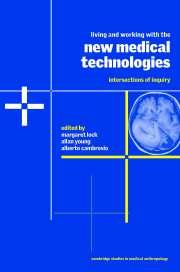Book contents
- Frontmatter
- Contents
- List of contributors
- 1 Introduction
- Part I Epochal transitions? Biomedicine and the transformation of socionature
- Part II Laboratories and clinics: the material cultures of biomedicine
- Part III Technologies and bodies: the extended networks of biomedicine
- 8 Screening the body: the pap smear and the mammogram
- 9 Extra chromosomes and blue tulips: medico-familial interpretations
- 10 When explanations rest: “good-enough” brain science and the new socio-medical disorders
- 11 On dying twice: culture, technology and the determination of death
- 12 The practice of organ transplants: networks, documents, translations
- Index
11 - On dying twice: culture, technology and the determination of death
Published online by Cambridge University Press: 23 December 2009
- Frontmatter
- Contents
- List of contributors
- 1 Introduction
- Part I Epochal transitions? Biomedicine and the transformation of socionature
- Part II Laboratories and clinics: the material cultures of biomedicine
- Part III Technologies and bodies: the extended networks of biomedicine
- 8 Screening the body: the pap smear and the mammogram
- 9 Extra chromosomes and blue tulips: medico-familial interpretations
- 10 When explanations rest: “good-enough” brain science and the new socio-medical disorders
- 11 On dying twice: culture, technology and the determination of death
- 12 The practice of organ transplants: networks, documents, translations
- Index
Summary
The enterprise of organ transplantation is like no other among biomedical technologies in that the rapid conversion of the technologically managed death of one patient is transformed into the “gift of life” for a second dying patient. By far the majority of solid organ transplants make use of what is known as a “brain dead donor.” A three-year-old is hit by the neighbor's car as it swings into the driveway; a sixteen-year-old hangs himself when his girlfriend tells him she does not want to see him any more; a stray bullet lodges itself in the brain of an innocent passer-by at a bank robbery; a middle-aged woman falls unconscious with a massive brain hemorrhage – patients such as these are placed on the artificial ventilator, permitting them to breathe even though they have lost the spontaneous capacity to do so, and are subjected to a battery of tests, scans and clinical examinations. Certain of these individuals will make a partial or complete recovery, but the hearts of others will stop beating, or their blood pressure will drop irrevocably, and they will then die in spite of the ventilator.
There is a third class of patients, those who neither recover nor die but become brain dead. For these patients, resuscitative measures are only a “partial success” (Ad Hoc Committee of the Harvard Medical School to Examine the Definition of Death 1968) so that with the assistance of the ventilator, the heart and lungs of such patients continue to function, but the entire brain is irreversibly damaged. Brain dead patients exist betwixt and between, both alive and dead; breathing with technological assistance, but unconscious.
- Type
- Chapter
- Information
- Living and Working with the New Medical TechnologiesIntersections of Inquiry, pp. 233 - 262Publisher: Cambridge University PressPrint publication year: 2000
- 18
- Cited by



